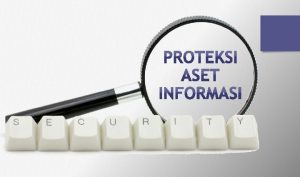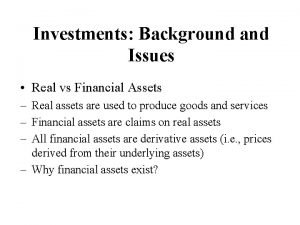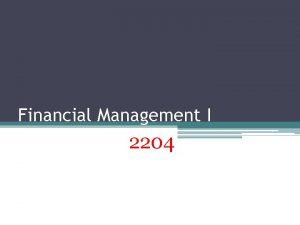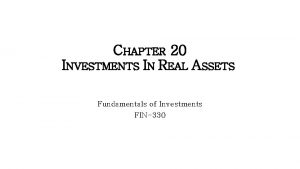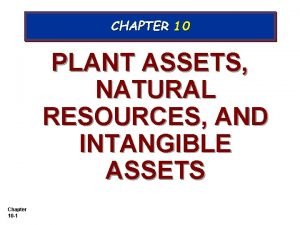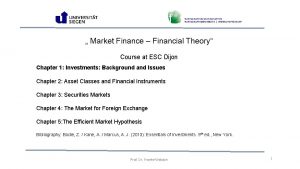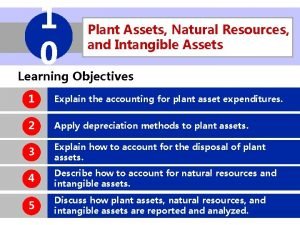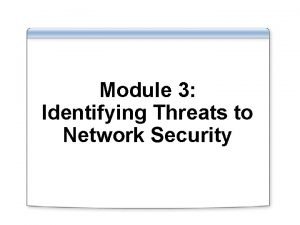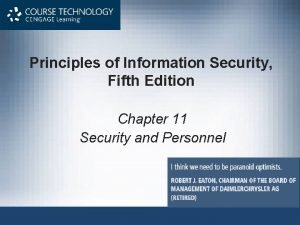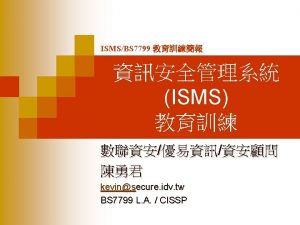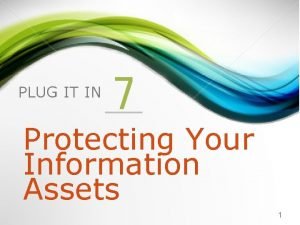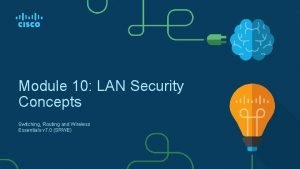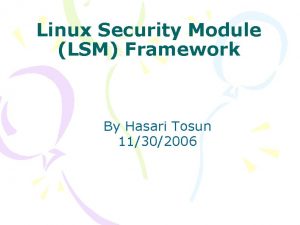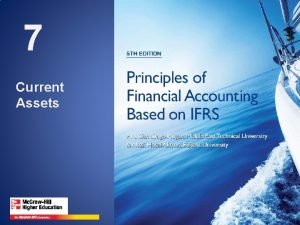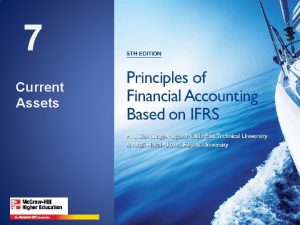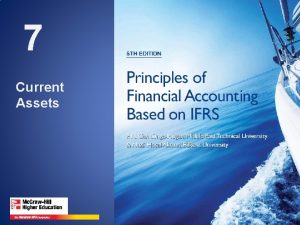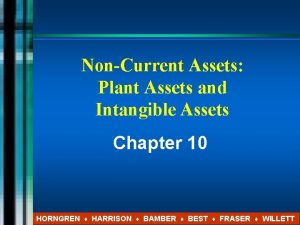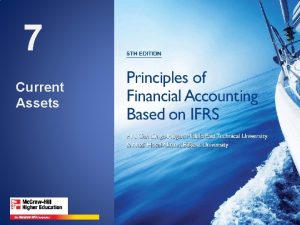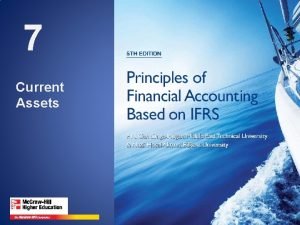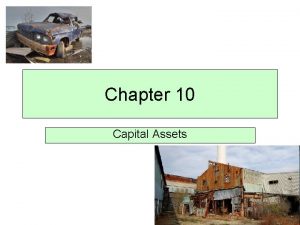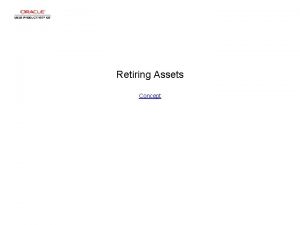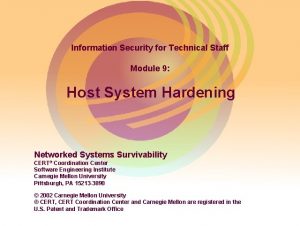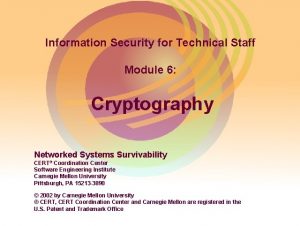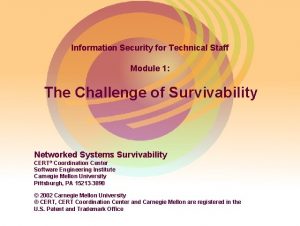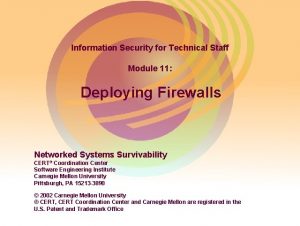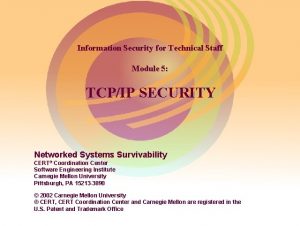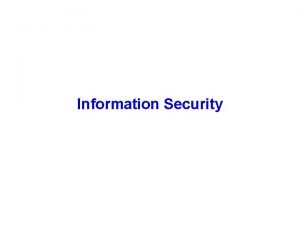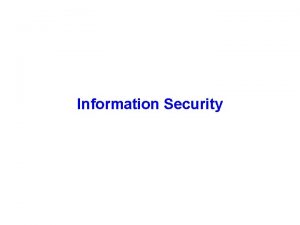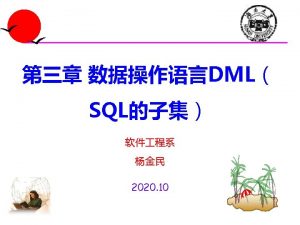Information Security For Technical Staff Module 2 Assets










![Security Requirements Each [critical] asset has different requirements of confidentiality, integrity, and availability, that Security Requirements Each [critical] asset has different requirements of confidentiality, integrity, and availability, that](https://slidetodoc.com/presentation_image_h/18ac0985d7bb881aed1faec7add42933/image-11.jpg)










- Slides: 21

Information Security For Technical Staff Module 2: Assets and Risk Management Networked Systems Survivability CERT® Coordination Center Software Engineering Institute Carnegie Mellon University Pittsburgh, PA 15213 -3890 © 2002 Carnegie Mellon University ® CERT, CERT Coordination Center and Carnegie Mellon are registered in the U. S. Patent and Trademark Office

Instructional Objectives Discuss the components of risk and the concepts of risk management Describe the importance of identifying and prioritizing assets Describe risk analysis techniques Identify methods of managing risks © 2002 Carnegie Mellon University Module 2: Assets and Risk Management - slide 2

Overview Define risk and recognize impact Assets, threats, vulnerabilities and safeguards Risk management, risk assessment and analysis © 2002 Carnegie Mellon University Module 2: Assets and Risk Management - slide 3

Risk is the possibility of suffering a loss, destruction, modification, or denial of availability of an asset. © 2002 Carnegie Mellon University Module 2: Assets and Risk Management - slide 4

Risk Impact The nature of information and systems allows significant risks that may result in: • Loss or compromise of critical information • Loss or compromise of key technologies • Loss of competitive position • Loss of customer confidence • Loss of trust in the organization’s computers/network system • Loss of revenue • Loss of life or property • Loss due to monetary fine, law suit, or regulatory penalty © 2002 Carnegie Mellon University Module 2: Assets and Risk Management - slide 5

Understanding Risk Requires: • Identifying and prioritizing assets • Relating threats and vulnerabilities • Performing risk analysis • Recognizing risk must be managed Risk can be mitigated, but cannot be eliminated © 2002 Carnegie Mellon University Module 2: Assets and Risk Management - slide 6

Assets and asset value • Information Assets • Other supporting assets • Critical assets © 2002 Carnegie Mellon University Module 2: Assets and Risk Management - slide 7

Information Assets Information Hardware Software People © 2002 Carnegie Mellon University Module 2: Assets and Risk Management - slide 8

Other Supporting Assets Facilities Utilities Outsourced Services © 2002 Carnegie Mellon University Module 2: Assets and Risk Management - slide 9

Critical Assets are assets determined to have an integral relationship with the mission of the organization and its success; recognizing that each individual organization will define a different set. Examples: • Intellectual property / patents / copyrights • Corporate financial data • Customer sales information • Human resource information © 2002 Carnegie Mellon University Module 2: Assets and Risk Management - slide 10
![Security Requirements Each critical asset has different requirements of confidentiality integrity and availability that Security Requirements Each [critical] asset has different requirements of confidentiality, integrity, and availability, that](https://slidetodoc.com/presentation_image_h/18ac0985d7bb881aed1faec7add42933/image-11.jpg)
Security Requirements Each [critical] asset has different requirements of confidentiality, integrity, and availability, that should be: • Communicated • Detailed • Documented © 2002 Carnegie Mellon University Module 2: Assets and Risk Management - slide 11

Threats, Safeguards, and Vulnerabilities Vulnerability: absence or weakness of a safeguard Safeguard: control or countermeasure employed to reduce risk associated with a specific threat © 2002 Carnegie Mellon University Threat: occurrence of any event that causes an undesirable impact or loss Module 2: Assets and Risk Management - slide 12

Calculating Risk Exposure Use exposure values to: • Prioritize the order in which risks are addressed • Help in deciding how to manage risks A new worm attacks vulnerable systems Web site defacement Datacenter flooded by fire protection system © 2002 Carnegie Mellon University Module 2: Assets and Risk Management - slide 13

Calculating Risk Where Metric = $ Exposure Factor (EF) • % of loss of an asset Single Loss Expectancy (SLE) • EF x Value of asset in $ Annualized Rate of Occurrence (ARO) • A number representing frequency of occurrence of a threat - Example: 0. 0 = Never 1000 = Occurs very often Annualized Loss Expectancy (ALE) • Dollar value derived from: SLE x ARO © 2002 Carnegie Mellon University Module 2: Assets and Risk Management - slide 14

Simple Risk Assessment Matrix Asset = Organization’s Intranet Web Server © 2002 Carnegie Mellon University Module 2: Assets and Risk Management - slide 15

Detailed Risk Assessment Matrix © 2002 Carnegie Mellon University Module 2: Assets and Risk Management - slide 16

Risk Management is process used to identify, analyze, and mitigate the risk (comprised of threats, vulnerabilities, safeguards and assets); and provide strategies for sustaining the security requirements of an information asset. © 2002 Carnegie Mellon University Module 2: Assets and Risk Management - slide 17

Managing Risks Accept Transfer Acknowledge that the risk exists, but apply no safeguard (Exposure value is within tolerance) Shift responsibility for the risk to a third party (ISP, MSSP, Insurance, etc. ) Risk Mitigate Change the asset’s risk exposure (apply safeguard) © 2002 Carnegie Mellon University Avoid Eliminate the asset’s exposure to risk, or eliminate the asset altogether Module 2: Assets and Risk Management - slide 18

Risk Transference Issues Outsourcing Risk Trust dilemma Residual risk © 2002 Carnegie Mellon University Module 2: Assets and Risk Management - slide 19

Review Questions 1. What are the components of risk? 2. Why do we prioritize one asset over another? 3. What two properties are analyzed and calculated as part of a simple risk assessment? 4. What are a few of the items completed in a risk assessment? © 2002 Carnegie Mellon University Module 2: Assets and Risk Management - slide 20

Module Summary Assets and asset value must be understood Risk can be both qualitative and quantitative Risk management Risk can be mitigated, but never eliminated © 2002 Carnegie Mellon University Module 2: Assets and Risk Management - slide 21
 Klasifikasi aset informasi
Klasifikasi aset informasi Financial assets vs real assets
Financial assets vs real assets Real assets vs financial assets
Real assets vs financial assets Real assets vs financial assets
Real assets vs financial assets Plant assets natural resources and intangible assets中文
Plant assets natural resources and intangible assets中文 Accumulated depreciation straight line method
Accumulated depreciation straight line method Financial assets examples
Financial assets examples Plant assets, natural resources, and intangible assets
Plant assets, natural resources, and intangible assets Private secuirty
Private secuirty Module 3: information and network security
Module 3: information and network security Technical university of cluj-napoca academic staff
Technical university of cluj-napoca academic staff Visa international security model in information security
Visa international security model in information security Cnss security model
Cnss security model Is a cornerstone in the protection of information assets
Is a cornerstone in the protection of information assets Information assets
Information assets Cover your information assets
Cover your information assets C device module module 1
C device module module 1 Fire security technical
Fire security technical Stp manipulation attack
Stp manipulation attack General security
General security Linux security module
Linux security module Kontinuitetshantering i praktiken
Kontinuitetshantering i praktiken
